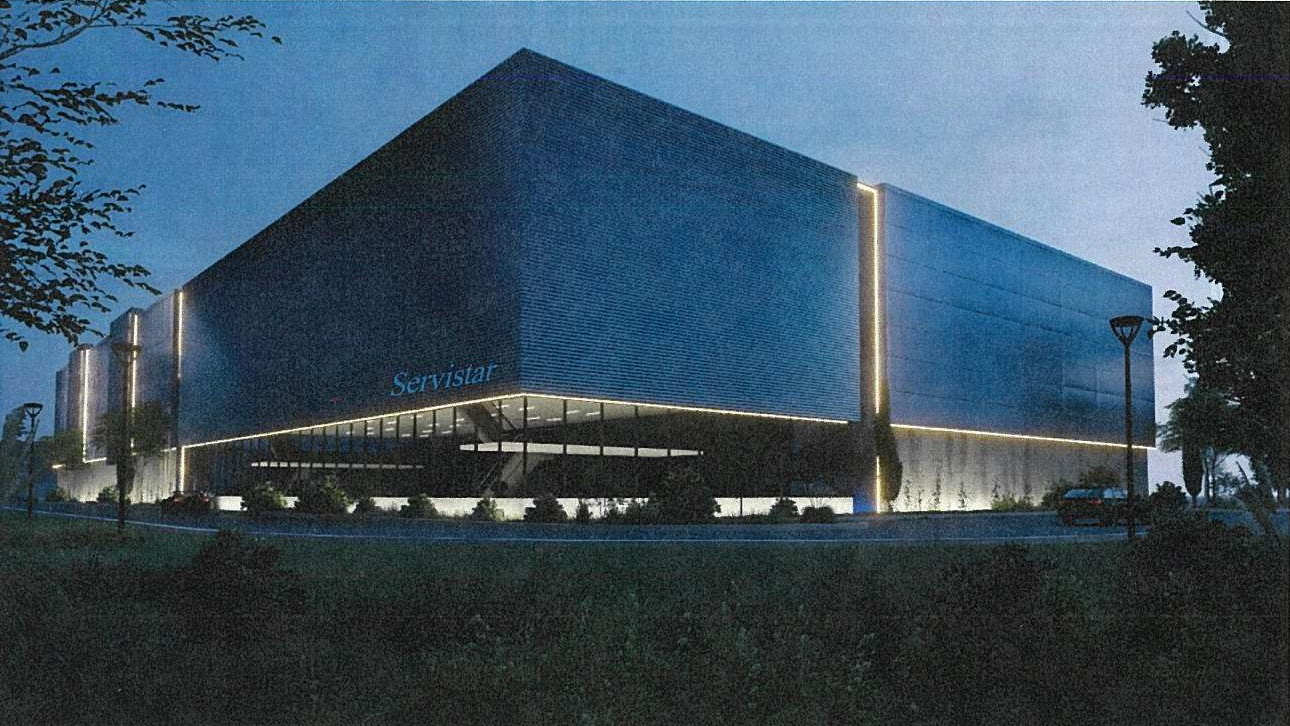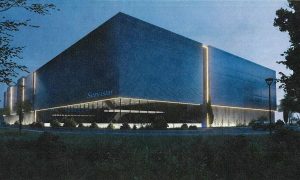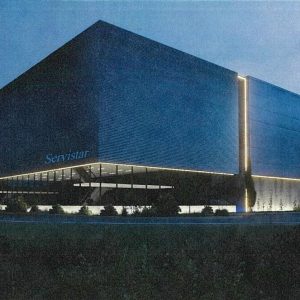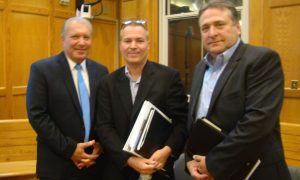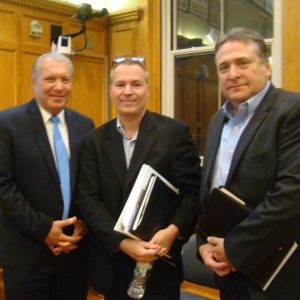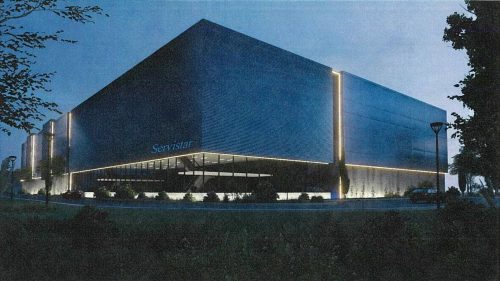
Servistar Realties LLC is proposing building 10 computer server data centers, like the one in this architect’s rendering, off Servistar Industrial Way in Westfield. (SUBMITTED IMAGE)
WESTFIELD — In a separate process than the one before the City Council, Servistar Realties went before the Planning Board on Oct. 19 for a continued hearing on a special permit and site plan for the Westfield Data Center Campus. Satisfied after more than an hour of questions and answers, board members voted unanimously to approve the permits.
Following up on issues raised in an earlier hearing, Eric J. Bartone, Servistar principal, brought the specifications for the proposed fire prevention systems and the diesel generators, two areas of concern due to the proximity of the project to the aquifer.
Bartone said there would be two kinds of fire protection, a wet system which is a high-pressure, low-volume system for the loading docks, office space and areas that don’t have the electrical equipment; and an inert gas system that uses a chemical to snuff out oxygen for the data halls, and is designed to reduce insurance liability and equipment loss.
“They’ve gone through multiple life cycles of the original types [of chemicals] used in those systems. A lot of the manufacturers have moved towards more biodegradable, low-impact chemicals that can easily be collected manually,” he said.
Regarding the diesel-generator tanks, Bartone said the data centers design their generator systems to meet the full load of a data center plus one generator, 13 for each data center building. He said the size of the generators is based on the potential for outages. Each one has dedicated fuel storage underneath in a double-lined, stationary tank that is electronically monitored for spills.
Planning Board alternate member Richard Salois commented that containment around the tanks would still be necessary, because “you have to fill them with a human being and a hose.” Bartone said Servistar supports using containment tanks. Salois also recommended scrubbers to collect the exhaust on each tank, which Bartone said are built in.
Bartone said the range for the diesel tanks is 6,500 to 13,000 gallons, and would depend upon outage studies that are done on uptime for the Eversource transmission grid.
“Engineers run probabilities on worst-case scenarios that will determine the size of the tank requirements. Outage numbers we’ve gotten back show they probably will be on the lower end. Uptime calculations from them are a lot better than industry standards. I would guess it wouldn’t change per building,” he added.
Alternate member Bernard Puza asked what would be the disadvantage to a natural gas or dual-fuel generator.
Bartone said they are not as reliable, and increase maintenance and run times.
“The industry is still with diesel generators. It is moving towards natural gas systems,” he said, adding that the diesel generators have 12- to 15-year life cycles. He said if there is a transmission change, any fuel would be pumped out and the systems removed, and the buildings would be retrofitted with a new generator with natural gas.
“Current designs do bring in natural gas up front, they don’t wait. It may not get used, but it’s there. We’re seeing that happening more now. It is something that’s going to get built into this design,” he said.
When asked why not use natural gas from the start, Bartone said they wanted to, but got pushback from engineers. He said engineers cite a 45-second delay in getting a natural gas generator running in the event of a power outage.
“We’re not quite there yet. The technical design folks are a little hesitant,” he said, adding the transition should take place over the next few years.
Member Cheryl Crowe asked about the 400 gallons of water per building that had been projected. She said some of the buildings are much larger, and asked whether that estimate would cover them.
Bartone said the 400 gallons is an average use per building, and includes employee usage and water cooling systems.
“These aren’t going to be big water consumers,” he said, adding that usually landscaping uses significantly more water than buildings do for a site this size. He said there won’t be a lot of landscaping or grass on this site.
Asked about fencing, Bartone said typical fences would be architectural, 10 feet high, and use security systems with alerts.
Salois asked when after approvals would the project break ground. Bartone said they have projected the fall of 2023. He said a big piece of the project will be a large amount of site work interconnecting with the utilities, beginning with a high-voltage utility yard and accessory building to connect with Eversource.
During the public comment section of the meeting, Ward 1 resident Joshua Ouellette said a forest isn’t something to be given up lightly. He asked if the project goes through, would the developers plant native plants for a meadow, to create a more natural habitat for pollinators.
Bartone said he grew up on an apple farm where they raised bees, and he was very active in the farm. He added that he knows bee populations are declining.
“We are open to having conversations about it. We have 160 acres, [and] 80 acres is property we’re not going to use.”
He also said that a lot of people have made the comment that that land is wetlands that they can’t use, which he said is an inaccurate statement, as a lot of it is uplands that could be used. He said there will be land that can be used for bee-friendly and environmentally-friendly plantings.
Bartone also said that when they talked about amenities, the industry is a big proponent of education and drawing from the local community.
“It’s a very kid-friendly industry. These kids are very attuned to technology,” he said, adding that they will be interested in creating a bridge between the data center and the educational community.

